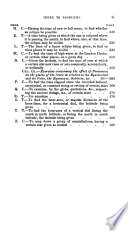 that every particle of matter in the universe attracts every other particle, with a force whose direction is that of the line joining the two, and whose magnitude is directly as the product of their masses, and inversely as the square of their distances... that every particle of matter in the universe attracts every other particle, with a force whose direction is that of the line joining the two, and whose magnitude is directly as the product of their masses, and inversely as the square of their distances...  Astronomy - 224. oldalszerző: sir John Frederick W. Herschel (1st bart.) - 1833Teljes nézet Astronomy - 224. oldalszerző: sir John Frederick W. Herschel (1st bart.) - 1833Teljes nézet - Információ erről a könyvről
 | Thomas Webster - 1837 - 512 oldal
...at the surface. For this purpose, he reasoned on his law of universal gravitation, which may be thus stated; ' Every particle of matter in the universe attracts every other particle, with a force varying inversely as the square of the distance.' Reasoning on this law, he calculated, from the effect... | |
 | 1839 - 272 oldal
...from gravitation. The great Newton discovered and established the law of universal gravitation, " that every particle of matter in the universe attracts every other particle, with a force varying inversely as the square of the distance :" by which is meant, that if a body be attracted by... | |
 | T H. Howe - 1842 - 458 oldal
...that case, the general law applies in its strict wording." — Sir John Herschefs Astronomy p. 237. " Every particle of matter in the universe attracts...particle with a force directly proportioned to the mas of the attracting particle, and inversely to the square of the distance between them." — Ibid,... | |
 | 1905 - 862 oldal
...constitution; this being, of course, only a particular case of Newton's law of gravitation, which tells us that every particle of matter in the universe attracts every other particle with a force which depends on their masses and on the distances which separate them; the attraction being proportionately... | |
 | 1846 - 534 oldal
...gravitation and attraction, by which all bodies, liquid or solid, are governed. Newton's words are — " Every particle of matter in the universe attracts...particle with a force directly proportioned to the mass (and density) of the attracting particle, and inversely to the square of the distance between them... | |
 | Archibald Tucker Ritchie - 1850 - 580 oldal
...opinion of astronomers. Sir John F. Herschel, in referring to Newton's law of gravitation, says — " Every particle of matter in the universe attracts...directly proportioned to the mass of the attracting partiele, and inversely to the square of the distance between them." And again — " It is in consequence... | |
 | Robert Grant - 1852 - 686 oldal
...advancement in the study of Celestial Mechanics. Already the sublime truth announced by Newton, that every particle of matter in the universe attracts every other particle with a force varying reciprocally as the squares of their mutual distances, has been realised in tbe motions of... | |
 | 1855 - 864 oldal
...Apple to his feet and established the memorable, universal Law ; namely, that, every individual partick of matter in the universe attracts every other particle, with a. force, directly as the mass of the attracting particle, and inversely as the squares of their distances. And lo ! the... | |
 | 1857 - 592 oldal
...velocity of projection, and that the magnitude and form of the orbit is calculable. He who announced that every particle of matter in the universe attracts every other particle, with a force varying inversely as the square of the distance, and directly as the mass, ivas not ignorant of, or... | |
 | Thomas Ewbank - 1858 - 170 oldal
...impellers. The established theory of cosmical movements is based on the principle that 'every particle in the universe attracts every other particle, with...directly proportioned to the mass of the attracting particles and inversely to the square of the distance between them.' The common notion attached to... | |
| |